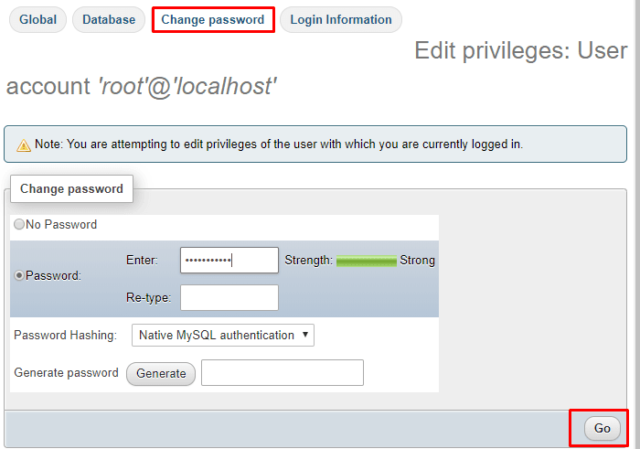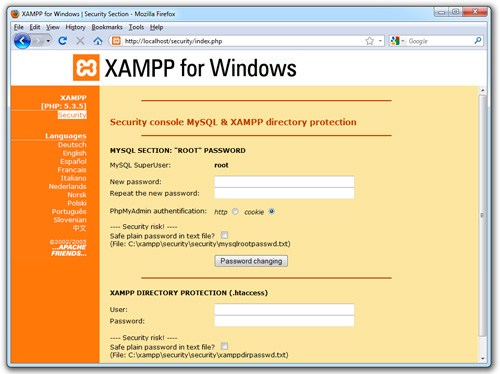
- #Find out localhost phpmyadmin password how to#
- #Find out localhost phpmyadmin password update#
- #Find out localhost phpmyadmin password software#
#Find out localhost phpmyadmin password software#
SFC is a not-for-profit organization that helps promote, improve, develop, and defend Free, Libre, and Open Source Software (FLOSS) projects.

#Find out localhost phpmyadmin password how to#
It is simple, just go to the installation folder / directory of PHPMyAdmin and open config.in. How to get phpmyadmin username and password Asked Viewed 197k times 21 I have intalled phpmyadmin recently in my system.

The phpMyAdmin project is a member of Software Freedom Conservancy. How to extract PhpMyAdmin username and password from its files. When the project turned 15, we published a celebration page. is created to provide wise and useful solutions for different IT related issues, problems, etc. Once you are logged in, you need to select your WordPress database. Typically, the username is root with no password. PhpMyAdmin is a mature project with a stable and flexible codeīase you can find out more about the project and its history and the awards it earned. Simply visit phpMyAdmin control panel by typing this URL in your browser’s address bar: You will be asked to provide your MySQL username and password. To ease usage to a wide range of people, phpMyAdmin is being translated into 72 languages and supports both LTR How to extract PhpMyAdmin username and password from its files.

PhpMyAdmin is also very deeply documented in a book written by one of the developersĮffective MySQL Management, which is available in English and Spanish. It is simple, just go to the installation folder / directory of PHPMyAdmin and open config.in. You face any problem you can use a variety of support channels to get The phpMyAdmin team will try to help you if Section 2: Features and Functionality 2.1 Database Management Localhost/phpMyAdmin. On Ubuntu and Debian: sudo /etc/init.PhpMyAdmin comes with a wide range of documentation and users are welcome to Open your browser and navigate to ' to access the phpMyAdmin interface.
#Find out localhost phpmyadmin password update#
Now the password has been reset, we need to restart MySQL by logging out: quit Steps are create a mysql-init.txt file containing UPDATE er SET PasswordPASSWORD ('newpass') WHERE User'root' FLUSH PRIVILEGES I saved it as C:\me\mysql-init and in command prompt I wrote- C:\wamp\bin\mysql\mysql5.5.8\bin\mysqld -init-fileC:\me\mysql-init.txt I tried with double backslashes also.but it is not working. Next, instruct MySQL which database to use: use mysql Įnter the new password for the root user as follows: update user set password=PASSWORD("mynewpassword") where User='root' Īnd finally, flush the privileges: flush privileges Note: No password is required at this stage as when we started MySQL we skipped the user privileges table. mysql -u root Note: No password is required at this stage as when we started MySQL we skipped the user privileges table.

You may need to log in using your current. Once it opens, click on the Admin button for MySQL. Note: The ampersand (&) at the end of the command is required.Īll we need to do now is to log into MySQL and set the password. Localhost/phpMyAdmin is a powerful, open-source tool that simplifies the management of MySQL and MariaDB databases. Login All we need to do now is to log into MySQL and set the password. To change the phpMyAdmin password on XAMPP, you first need to launch the XAMPP Control Panel. Again, note that you will need to have sudo access for these commands so you don't need to worry about any user being able to reset the MySQL root password: sudo mysqld_safe -skip-grant-tables & Next we need to start MySQL in safe mode - that is to say, we will start MySQL but skip the user privileges table. If you are using Ubuntu or Debian the command is as follows: sudo /etc/init.d/mysql stopįor CentOS, Fedora, and RHEL the command is: sudo /etc/init.d/mysqld stop The default username is 'root' default password is (empty/blank).


 0 kommentar(er)
0 kommentar(er)
